Potřebujeme váš souhlas k využití jednotlivých dat, aby se vám mimo jiné mohly ukazovat informace týkající se vašich zájmů. Souhlas udělíte kliknutím na tlačítko „OK“.
ASTM D5753-05(2010)
Standard Guide for Planning and Conducting Borehole Geophysical Logging
Automaticky přeložený název:
Standardní Guide pro plánování a provádění vrtů Geofyzikální protokolování
NORMA vydána dne 1.5.2010
Informace o normě:
Označení normy: ASTM D5753-05(2010)
Poznámka: NEPLATNÁ
Datum vydání normy: 1.5.2010
Kód zboží: NS-32394
Počet stran: 9
Přibližná hmotnost: 27 g (0.06 liber)
Země: Americká technická norma
Kategorie: Technické normy ASTM
Kategorie - podobné normy:
Zemní práce. Hloubicí práce. Budování základů. Podzemní práce
Anotace textu normy ASTM D5753-05(2010) :
Keywords:
acoustic logging, acoustic televiewer, borehole geophysics, borehole video, caliper logging, chemical properties and physical properties, deviation, electric logging, environmental, fluid conductivity/resistivity logging, fluid logging, gamma logging, gamma-gamma logging, geology, geophysics, geotechnical, groundwater, hydrology, induction logging, log calibration and standardization, log headings, neutron logging, nuclear logging, resistivity logging, singlepoint resistance logging
Doplňující informace
| Significance and Use | ||||||
|
An appropriately developed, documented, and executed guide is essential for the proper collection and application of borehole geophysical logs. The benefits of its use include improving the following: Selection of logging methods and equipment, Log quality and reliability, and Usefulness of the log data for subsequent display and interpretation. This guide applies to commonly used logging methods (see Table 1 and Table 2) for geotechnical investigations. It is essential that personnel (see 7.3.3) consult up-to-date textbooks and reports on each of the logging techniques, applications, and interpretation methods. A partial list of selected publications is given at the end of this guide. This guide is not meant to describe the specific or standard procedures for running each type of geophysical log and is limited to measurements in a single borehole. |
||||||
| 1. Scope | ||||||
|
1.1 This guide covers the documentation and general procedures necessary to plan and conduct a geophysical log program as commonly applied to geologic, engineering, groundwater, and environmental (hereafter referred to as geotechnical) investigations. It is not intended to describe the specific or standard procedures for running each type of geophysical log and is limited to measurements in a single borehole. It is anticipated that standard guides will be developed for specific methods subsequent to this guide. 1.2 Surface or shallow-depth nuclear gages for measuring water content or soil density (that is, those typically thought of as construction quality assurance devices), measurements while drilling (MWD), cone penetrometer tests, and logging for petroleum or minerals are excluded. 1.3 Borehole geophysical techniques yield direct and indirect measurements with depth of the (1) physical and chemical properties of the rock matrix and fluid around the borehole, (2) fluid contained in the borehole, and (3) construction of the borehole. 1.4 To obtain detailed information on operating methods, publications (for example, 2, 5, 7, 18, 24, 29, 34, 35, and 36) should be consulted. A limited amount of tutorial information is provided, but other publications listed herein, including a glossary of terms and general texts on the subject, should be consulted for more complete background information. 1.5 This guide provides an overview of the following: (1) the uses of single borehole geophysical methods, (2) general logging procedures, (3) documentation, (4) calibration, and (5) factors that can affect the quality of borehole geophysical logs and their subsequent interpretation. Log interpretation is very important, but specific methods are too diverse to be described in this guide. 1.6 Logging procedures must be adapted to meet the needs of a wide range of applications and stated in general terms so that flexibility or innovation are not suppressed. 1.7 This standard does not purport to address all of the safety and liability concerns, if any, (for example, lost or lodged probes and radioactive sources ) associated with its use. It is the responsibility of the user of this standard to establish appropriate safety and health practices and determine the applicability of regulatory limitations prior to use. 1.8 This guide offers an organized collection of information or a series of options and does not recommend a specific course of action. This document cannot replace education or experience and should be used in conjunction with professional judgment. Not all aspects of this guide may be applicable in all circumstances. This ASTM standard is not intended to represent or replace the standard of care by which the adequacy of a given professional service must be judged, nor should this document be applied without consideration of a project's many unique aspects. The word “Standard” in the title of this document means only that the document has been approved through the ASTM consensus process. |
||||||
| 2. Referenced Documents | ||||||
|
Podobné normy:
Historická
1.6.2014
Historická
1.2.2006
Historická
1.5.2011
Historická
1.5.2011
Historická
15.6.2009
Historická
1.10.2008
Doporučujeme:
Aktualizace technických norem
Chcete mít jistotu, že používáte pouze platné technické normy?
Nabízíme Vám řešení, které Vám zajistí měsíční přehled o aktuálnosti norem, které používáte.
Chcete vědět více informací? Podívejte se na tuto stránku.


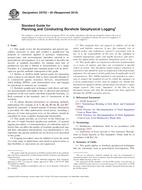
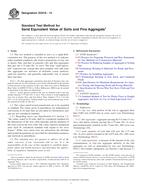 ASTM D2419-14
ASTM D2419-14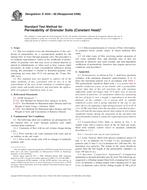 ASTM D2434-68(2006)..
ASTM D2434-68(2006)..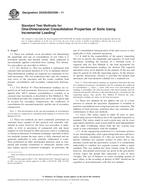 ASTM D2435/D2435M-11..
ASTM D2435/D2435M-11..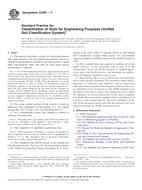 ASTM D2487-11
ASTM D2487-11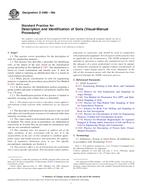 ASTM D2488-09a
ASTM D2488-09a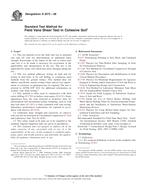 ASTM D2573-08
ASTM D2573-08
 Cookies
Cookies
